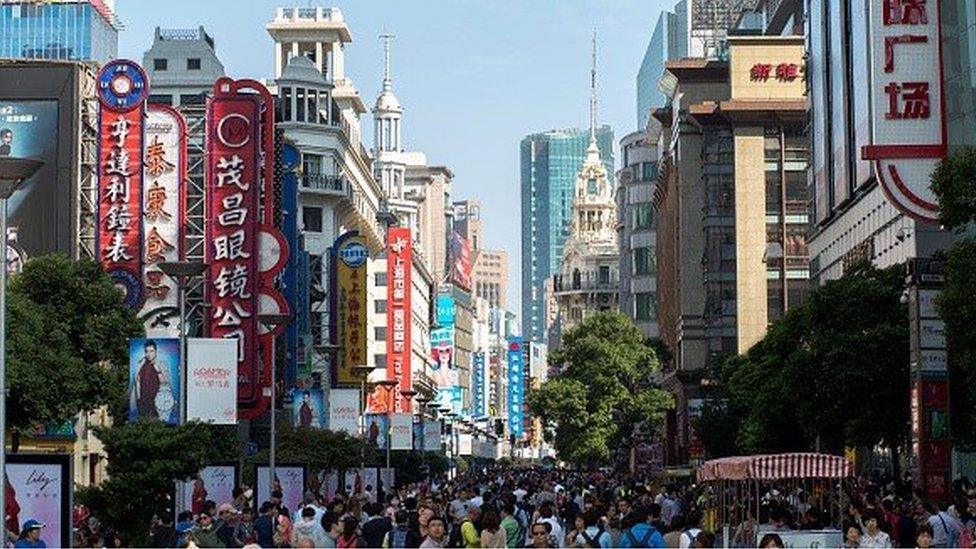Is China really growing at 6.9%?
- Published
- comments

On paper, China's economy grew a little bit faster than most analysts expected in the three months to the end of September - although at its slowest rate since just after the 2008 global crash.
How much is that paper worth - are the figures reliable?
And in the hours before President Xi arrives for the nuclear-powered pomp of a state visit to Britain, what can we glean from the numbers that's of relevance to us?
Well it's doubtful that if China's economy was measured in the way we measure ours that it would be showing the 6.9% annual growth announced today.
To illustrate, economists are divided not only on the outlook for China, but on what actually happened in the recent past.
For example, in the second quarter of this year, China announced 7% growth, bang on its official target for 2015. But a number of economists calculated that the true underlying figure was nearer 4%,
So China's 6.9% for the subsequent period should be taken with a healthy pinch of salt.
That said, what its National Bureau of Statistics says about the underlying drivers of expansion is of interest.
'Incongruous'
Industrial output in September, which has driven China's economy for decades, grew at its slowest rate since 2008 at 5.7% - whereas retail sales increased 10.9%.
If reliable, these trends point to a needed and healthy rebalancing of China's economy - more towards domestic consumption, and away from its traditional and unhealthily large dependence on exports.
Other numbers told a similar encouraging story - services expanding 8.4% in the quarter, compared with 6% growth in "secondary industry", including manufacturing.
But it is incongruous that domestic consumption should be accelerating at this precise juncture, given that the wealth of tens of millions of middle class Chinese was battered over the summer by the fall in the Shanghai stock market.
What's more, recent initiatives taken by Beijing to sustain growth are not wholly benign, or at least not for the long term.
Remember this is a country whose debts have expanded dangerously fast over the past six years, by not far off 100 percentage points of GDP.
So there is reason to be mildly concerned that stimulus measures are directed towards spurring yet more lending: in the past year there have been five interest rate cuts, three cuts in so-called reserve ratios whose effect is to lessen constraints on the creation of credit by banks, facilitation of borrowing by local authorities to finance yet more "grand projects", and a speeding up of approvals for big infrastructure projects.
Or to put it another way, the government may recognise that the country since 2008 has become dangerously hooked on investment financed by borrowing, but is refusing to go cold turkey on this addiction to debt-fuelled growth.
Which may make sense, to ease the reconstruction of the economy from one unsustainably dependent on exports, heavy industry, property development, infrastructure spending and borrowing (or trade and debt-financed investment in shorthand).
'Disproportionate pain'
But the risk of it all coming to a juddering and painful halt is heightened the more that the debt bubble is pumped up.
All that said, any Chinese growth, if real, now has a disproportionate impact on the global economy.
And the corollary, of course, is that any slowdown beyond what's expected by client economies all over the world - manufacturers like Germany, commodity producers like Brazil - engenders disproportionate pain.
The point is that China, on the purchasing power parity measure which attempts to assess physical output undistorted by exchange rate movements, is the world's biggest economy, according to the World Bank - representing 16.7% of global GDP or output, compared with 16% for America (which is still the number one economy on the conventional GDP measure).
This means that if its current GDP growth is accurate, China is actually contributing a little bit more to global growth at its new putative expansion rate rate of 6.9% than it did in the boom years of 2003-7, when its economy was growing at the hair-raising rate of 11.7%.
Or to put it another way, China today is in theory contributing more than one percentage point of global GDP expansion compared with almost exactly one percentage point just before the 2008 debacle.
That said, it probably won't have escaped your notice that the global economy is in fact slowing down pretty sharply, to well below its long term average expansion rate, with the weakest economies citing China's slowdown as the primary cause of their woes.
Something doesn't add up.
Or to state the bleedin' obvious, we are still some way from a robust understanding of both the current condition of China's complex sprawling economy and its direction - with the implication that our prosperity will be determined both by the changing reality and the changing perception of what's going on there.